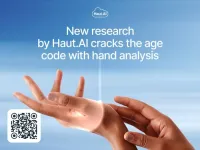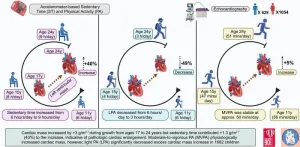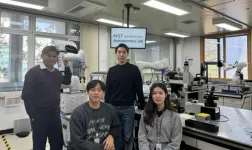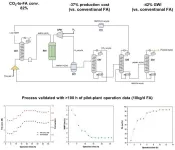(Press-News.org)
Tallinn, Estonia – 7th May 2024, 10 AM CET – Haut.AI, a leader in responsible skincare artificial intelligence (AI) development, today announced a breakthrough research paper demonstrating the effectiveness of using hand images for accurate age prediction. This innovative approach offers a viable alternative to traditional facial photo methods and promotes fairer AI solutions.
The study, titled “Predicting human chronological age via AI analysis of dorsal hand versus facial images: A study in a cohort of Indian females,” shows that AI models trained on hand images achieve comparable accuracy to those using facial images, with an average error of 4.1 and 4.7 years in predicting chronological age. This research is particularly significant for ethnic skin, as it was trained using the Indian population dataset and represents the first AI model for age prediction specifically designed with a diverse dataset that includes a wide range of skin tones.
“Our research demonstrates that your age can be determined just as accurately from a picture of your hands as from your face,” said Anastasia Georgievskaya, the CEO of Haut.AI. “This not only opens doors for new applications of AI technology but also has the potential to mitigate biases often associated with conventional systems. This aligns perfectly with our commitment to developing fair and responsible AI solutions.”
By using hand images, Haut.AI aims to address potential biases that can arise from facial recognition systems due to factors like ethnicity and facial features. The research emphasizes the importance of utilizing diverse datasets in AI development to ensure unbiased and inclusive solutions. This technology offers an alternative for situations where facial images are unavailable or less preferred.
Understanding the Aging Process:
The study goes beyond just the accuracy of age prediction. By analyzing how specific features on hands and faces influence the model’s predictions, the research contributes to a better understanding of the aging process. Researchers found that areas around the eyes, nose, mouth, and forehead were important for facial age prediction by AI. These areas often show wrinkles, sagging, and other signs of aging. In hands, features like wrinkles, knuckles, and bone prominence were significant for age prediction. Antiaging interventions that address these features will make you look younger to neural networks and, most likely, to humans, too.
Haut.AI is committed to responsible AI development and fostering a future where technology benefits everyone. This research is a significant step forward in achieving these goals.
About HAUT.AI
Positioned as a leading European AI company, Haut.AI specializes in the delivery of highly personalized skincare and beauty experiences. Backed by world-class research, science, and technology teams, Haut.AI’s Software-as-a-Service (SaaS) platform was trained on an extensive dataset of three million image data points, allowing it to assess over 150 distinct multidimensional face biomarkers and enabling the delivery of interactive, customized aesthetic recommendations—with just the quick snap of a selfie!
Already embraced by leading names in the beauty, skincare, and pharmaceutical industries, Haut.AI’s platform is utilized by global brands such as Beiersdorf, Ulta Beauty, the largest beauty retailer in the United States, Almirall Pharma, Phoenix, and Dr Max Pharma.
As a proudly women-led company, Haut.AI is on a mission to establish personalized skincare as the new standard for beauty and wellness brands worldwide, all powered by the capabilities of artificial intelligence. To delve deeper into Haut.AI’s innovative approach, visit the website: www.haut.ai.
Media Contact
Anastasia Georgievskaya
CEO at Haut.AI
nastya@haut.ai
Article:
Georgievskaya, A., Tlyachev, T., Kiselev, K., Hillebrand, G., Chekanov, K., Danko, D., Golodyaev, A., & Majmudar, G. (2024). Predicting human chronological age via AI analysis of dorsal hand versus facial images: A study in a cohort of Indian females. Experimental dermatology, 33(3), e15045. https://doi.org/10.1111/exd.15045
https://doi.org/10.1111/exd.15045
END
Following a quinquennial review by the Biotechnology and Biological Sciences Research Council (BBSRC), the Babraham Institute will receive £48m for the period 2024-2028 to advance research on the mechanisms that maintain the health of our cells, tissues and organs across the life course.
This work is key in driving BBSRC’s strategic research priorities around an integrated understanding of health, developing and applying transformative technologies and advancing our understanding of the rules of life.
As one of eight UK bioscience ...
An increase in sedentary time from childhood caused progressing heart enlargement, a new study shows. However, light physical activity could reduce the risk. The study was conducted in collaboration between the Universities of Bristol and Exeter, and the University of Eastern Finland, and the results were published in the prestigious European Journal of Preventive Cardiology.
Left ventricular hypetrophy refers to an excessive increase in heart mass and size. In adults, it is known to increase the risk for heart attacks, stroke, and premature death.
In the present study, 1,682 children ...
PISCATAWAY, NJ – Teenagers are less likely to drink, smoke or use drugs when their parents keep tabs on their activities--but not necessarily because kids are more likely to be punished for substance use, suggests a new study in the Journal of Studies on Alcohol and Drugs.
Researchers found that, contrary to common belief, parents’ “monitoring” does not seem to boost the odds of catching their kids using substances. However, when kids simply are aware that their parents are monitoring behavior, they avoid trying alcohol or drugs in the first place.
It is the fear of being caught, rather than actually being punished.
Many studies ...
FOR IMMEDIATE RELEASE
Distant, far away galaxies. Interacting galaxies, whose shape has been forged by the mutual gravitational influence, but also galaxies forming groups and clusters, kept together by gravity. They are the protagonists of three new images released by the VLT Survey Telescope (VST).
VST is an optical telescope with a 2,6 diameter mirror, entirely built in Italy, that has been operating since 2011 at the European Southern Observatory’s (ESO) Paranal Observatory in Chile. Since 2022, the telescope has been fully managed by INAF through the National Coordination Centre for VST, ...
In the early 20th century, the development of a catalyst for ammonia synthesis by the Haber-Bosch method took more than 10,000 experiments before it was successful. The development of new materials is a time-consuming and costly process from design to commercialization. However, in recent years, researchers have been working to shorten the development period by using artificial intelligence (AI). When combined with robots, it is possible to conduct material development research 24 hours a day, 365 days a year without human ...
CCU (Carbon Capture & Utilization), which captures CO2 and converts it into useful compounds, is crucial for rapidly transitioning to a carbon-neutral society. While CCS (Carbon Capture & Storage), which only involves CO2 storage, has entered the initial commercialization stage due to its relatively simple process and low operational costs, CCU has only been explored at the research level due to the complexity of conversion processes and high production costs of compounds.
Dr. Lee Ung's team at the Clean Energy Research Center ...
Embargoed for release until 5:00 p.m. ET on Monday 6 May 2024
Annals of Internal Medicine Tip Sheet
@Annalsofim
Below please find summaries of new articles that will be published in the next issue of Annals of Internal Medicine. The summaries are not intended to substitute for the full articles as a source of information. This information is under strict embargo and by taking it into possession, media representatives are committing to the terms of the embargo not only on their own behalf, but also on behalf of the ...
KEY TAKEAWAYS
In a study of outpatient sites, researchers found that 7% of patients experienced at least one adverse event and 1.9% of patients experienced at least one preventable adverse event.
The most common adverse events in the outpatient setting were adverse drug events.
The findings highlight an urgent need to develop interventions to prevent both inpatient and outpatient harm.
Over the last several decades, research has brought nationwide awareness to issues of patient harm in the “inpatient” setting, where patients ...
MIAMI, FLORIDA (EMBARGOED UNTIL MAY 6, 2024 AT 3:00 P.M. EDT) – Researchers at Sylvester Comprehensive Cancer Center at the University of Miami Miller School of Medicine have developed a nanoparticle that can penetrate the blood-brain barrier. Their goal is to kill primary breast cancer tumors and brain metastases in one treatment, and their research shows the method can shrink breast and brain tumors in laboratory studies.
Brain metastases, as these secondary tumors are called, most commonly arise from solid tumors like breast, lung and colon cancer and are often associated with a poor prognosis. When cancer breaches ...
Engineers at Princeton and North Carolina State University have combined ancient paperfolding and modern materials science to create a soft robot that bends and twists through mazes with ease.
Soft robots can be challenging to guide because steering equipment often increases the robot’s rigidity and cuts its flexibility. The new design overcomes those problems by building the steering system directly into the robot’s body, said Tuo Zhao, a postdoctoral researcher at Princeton.
In an article published May 6 in the journal PNAS, the researchers describe how they created the robot out ...










